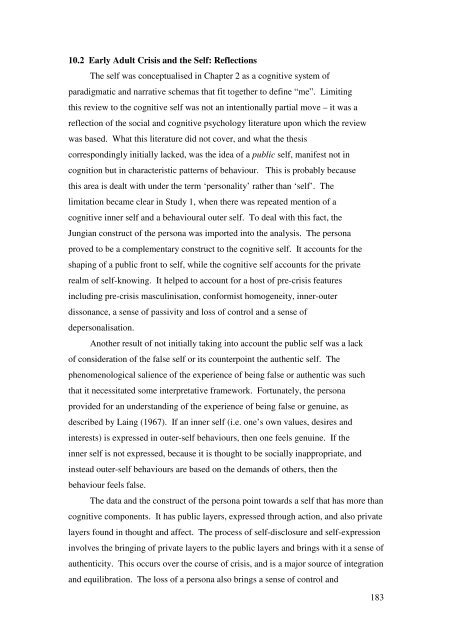DEVELOPMENTAL CRISIS IN EARLY ADULTHOOD: A ...
DEVELOPMENTAL CRISIS IN EARLY ADULTHOOD: A ...
DEVELOPMENTAL CRISIS IN EARLY ADULTHOOD: A ...
Create successful ePaper yourself
Turn your PDF publications into a flip-book with our unique Google optimized e-Paper software.
10.2 Early Adult Crisis and the Self: Reflections<br />
The self was conceptualised in Chapter 2 as a cognitive system of<br />
paradigmatic and narrative schemas that fit together to define “me”. Limiting<br />
this review to the cognitive self was not an intentionally partial move – it was a<br />
reflection of the social and cognitive psychology literature upon which the review<br />
was based. What this literature did not cover, and what the thesis<br />
correspondingly initially lacked, was the idea of a public self, manifest not in<br />
cognition but in characteristic patterns of behaviour. This is probably because<br />
this area is dealt with under the term ‘personality’ rather than ‘self’. The<br />
limitation became clear in Study 1, when there was repeated mention of a<br />
cognitive inner self and a behavioural outer self. To deal with this fact, the<br />
Jungian construct of the persona was imported into the analysis. The persona<br />
proved to be a complementary construct to the cognitive self. It accounts for the<br />
shaping of a public front to self, while the cognitive self accounts for the private<br />
realm of self-knowing. It helped to account for a host of pre-crisis features<br />
including pre-crisis masculinisation, conformist homogeneity, inner-outer<br />
dissonance, a sense of passivity and loss of control and a sense of<br />
depersonalisation.<br />
Another result of not initially taking into account the public self was a lack<br />
of consideration of the false self or its counterpoint the authentic self. The<br />
phenomenological salience of the experience of being false or authentic was such<br />
that it necessitated some interpretative framework. Fortunately, the persona<br />
provided for an understanding of the experience of being false or genuine, as<br />
described by Laing (1967). If an inner self (i.e. one’s own values, desires and<br />
interests) is expressed in outer-self behaviours, then one feels genuine. If the<br />
inner self is not expressed, because it is thought to be socially inappropriate, and<br />
instead outer-self behaviours are based on the demands of others, then the<br />
behaviour feels false.<br />
The data and the construct of the persona point towards a self that has more than<br />
cognitive components. It has public layers, expressed through action, and also private<br />
layers found in thought and affect. The process of self-disclosure and self-expression<br />
involves the bringing of private layers to the public layers and brings with it a sense of<br />
authenticity. This occurs over the course of crisis, and is a major source of integration<br />
and equilibration. The loss of a persona also brings a sense of control and<br />
183
















